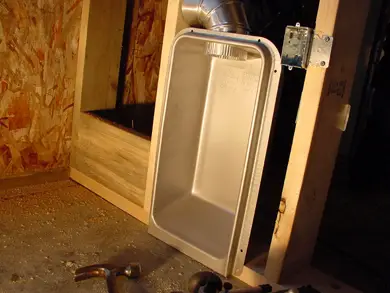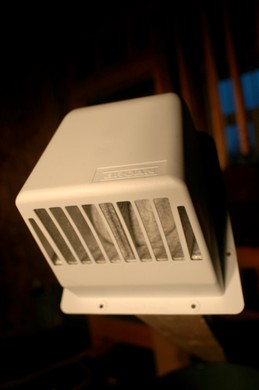Clothes dryer vents have got to be one of the last things that builders consider when they’re putting a house together, and it shows. Take a look behind just about any dryer and you’ll see what I mean. Crumpled flexible ducting made of what looks like recycled TV dinner trays gasps to survive as it snakes its way towards an ill-located exit hole, crushed against the back of a dryer pushed too close to the wall. But thankfully, the hardware necessary to complete a safe, first-rate, crumple-proof dryer ventilation hookup now exists. And it’s about time.
 Considering the stakes involved, the topic of dryer ventilation connections deserves a lot more attention than it gets. Poor quality dryer connections waste energy, they slow drying time, and they can admit enough cold air to encase the indoor portion of the vent in frozen condensation during ultra-cold weather. Bad dryer vents can even set your house on fire.
Considering the stakes involved, the topic of dryer ventilation connections deserves a lot more attention than it gets. Poor quality dryer connections waste energy, they slow drying time, and they can admit enough cold air to encase the indoor portion of the vent in frozen condensation during ultra-cold weather. Bad dryer vents can even set your house on fire.
More than 15,000 dryer fires occur each year across North America, and many of these can be traced back to crumpled vent pipes that trapped tinder-dry lint. And in the case of gas-fired dryers, bad vents even pose the hazard of carbon monoxide making its way into your home.
Both ends of most dryer vents usually beg for an upgrade, and I’ve discovered two pieces of hardware that make safety and quality easy to achieve.
The first is something called the Dryer Box (888-443-7937). It’s a stamped steel tray that creates a recess within the wall behind your dryer. Smooth, low-friction steel dryer ducting ends inside the box, creating a safe zone where the flexible ducting that connects to your dryer remains protected. You can even push your dryer right up against the wall and the flexible ducting remains unharmed. Although the product is made in the U.S., it’s available here in Canada.
Dryer Box is shallow enough that it allows 1-inch of rigid foam insulation to be installed behind it when recessed into a 2×6 exterior wall. This detail is essential in cold climates like ours. Without it, condensation and ice forms on the steel  during winter. During installation take the time to seal the area where the dryer box meets the wall and where the metal dryer vent pipe exits the box. It’s essential that warm, moist indoor air not enter the wall cavity. Forget this seemingly small matter and condensation will appear within wall cavities, promoting internal mold and rot.
during winter. During installation take the time to seal the area where the dryer box meets the wall and where the metal dryer vent pipe exits the box. It’s essential that warm, moist indoor air not enter the wall cavity. Forget this seemingly small matter and condensation will appear within wall cavities, promoting internal mold and rot.
Cold winters offer another reason to take a second look at the other side of your dryer vent, the place where the duct ends outdoors. This is where you’ll probably find a plastic vent flap that’s supposed to stop cold air from back-drafting into your dryer and your house. But have you ever seen a plastic flap vent that actually worked? Just open up the dryer on a cold day and see for yourself. It’s typically cold enough in there to safely store milk and eggs between loads of laundry. This is because the slightest breeze flips the lightweight flap up, letting enough cold air indoors to create significant ice build-up on the outside of many dryer vent pipes as it makes its way to your machine.
I’ve been testing a Canadian invention called Ecovent (Broan model#EV100; Home Depot). It solves the silly dryer flap problem once and for all. The heart of the Ecovent is a plastic hood that’s filled with rigid foam insulation surrounding a loose foam sealing ball. Gravity and wind both work to seal the ball tightly into the vent when the dryer is off. Dryer exhaust air opens it up elegantly when you switch on your machine. All in all, it’s a great solution to one of the unique challenges of being a Canadian in wintertime.